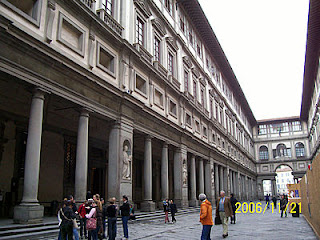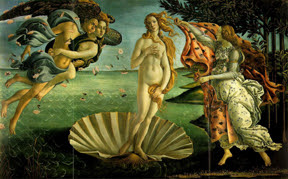
At the end of our tour of Florence we stopped at the Uffizi Gallery (Italian: Galleria degli Uffizi) for a guided walk through this awesome collection of artworks.
Building of the palace was begun by Giorgio Vasari in 1560 for Cosimo I de' Medici as the offices for the Florentine magistrates - hence the name "uffizi" (offices). Construction ended in 1581.

Over the years, parts of the palace evolved into a display place for many of the paintings and sculpture collected by the Medici family or commissioned by them. After the house of Medici was extinguished, the art treasures remained in Florence, forming one of the first modern museums. The gallery had been open to visitors by request since the sixteenth century, and in 1765 it was officially opened to the public.
This statue of Galileo can be found in one of the pillar alcoves on the outside of the gallery.
The problem with a visit to one of these magnificent European art galleries is that you see so much that in the end you cannot retain much at all. And of cource one is not allowed to take pictures inside these galleries. What follows are but a few of the artworks we saw and that we could recall afterwards.

Fra' Filippo Lippi (1406-1469), also called Lippo Lippi, is a well-known Florentine painter of the Italian 15th century school. His work is remarkable for the fact that he, though a monk, liked women very much, so that
(a) he had a son who himself became a famous painter, Filippino Lippi, and
(b) in his paintings the women were markedly prettier than had been customary.
One can see it in some of his Madonnas, like in this one, the "Madonna and Child with two Angels".
We particularly liked Botticelli's famous paintings of Aphrodite. He made a similar point of making the faces of female subjects look beautiful, in this case by giving a clear and well-shaped outline. Here is "The Birth of Venus" which Botticelli painted in about 1485.

The story goes that, born from a union between Heaven and Earth, there came forth a goddess with such beauty and charm that the seasons rushed to greet her. Her name was Aphrodite, which in Greek means "born of the sea foam". She was also known as "Aphrodite Pandemos" which means goddess "among all the people". Her Roman name was Venus.
Caravaggio"s paintings showing chiaroscuro (meaning strong contrasts in illumination between light and dark areas in the artwork) alerted us to the use of chiaroscuro to paint false beams and domes on ceilings that were so realistic that it was very hard to detect that it was two-dimensional.

We found Canaletto's (1697-1768) ordered and "architectural" paintings of Venice most appealing. This one is the Palazzo Ducale in Venice. Canaletto's views always fetched high prices, and as early as the 18th century Catherine the Great and other European monarchs vied for his grandest paintings.

We were surprised to learn how few paintings by Leonardo da Vinci existed, and how few of them were in Florence - just the "Annunciation" (shown here) and the unfinished "Adoration of the Magi". Da Vinci had quarrelled with Lorenzo de Medici and gone to France (where he died in 1519), so that the Mona Lisa is legitimately in the Louvre.

There is only one painting by Michelangelo in the Uffizi, this one of the Holy Family painted in about 1506 for the merchant Angolo Doni and his wife Maddalena Strozzi. The frame is original and was also designed by Michelangelo.

No comments:
Post a Comment